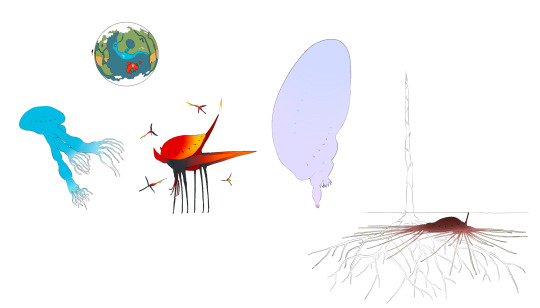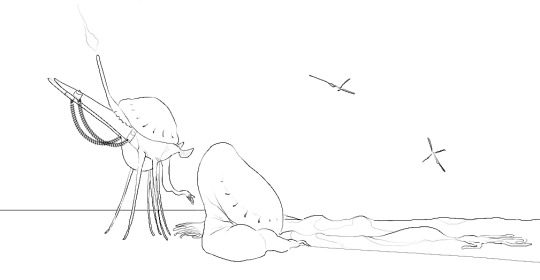On DeviantArt and YouTube as Concavenator: sometimes I draw and write about speculative biology, life on other worlds and in the far future, and the history of life on Earth.
Last active 2 hours ago
Don't wanna be here? Send us removal request.
Photo

Long before the introduction of color film, a Russian chemist and photographer named Sergey Prokudin-Gorsky used an innovative technique. He took three individual black and white photos, each through a colored filter (red, green, and blue), to create fully colored, high-quality pictures. The photo of this woman, taken by him, is around 107 years old!
17K notes
·
View notes
Text
hey guess who just got a Phucking Degree
Two weeks to finish and hand in my PhD thesis, and also to make a presentation about it. Pray for me to the little gods of protistkind.
76 notes
·
View notes
Text
We really are Suckbeasts, huh
But then around 30 million years ago — halfway through the Age of Mammals, give or take — something happened. The nautiloids started disappearing. Fewer species, less diversity. Bit by bit they shrank back into their current small range. What happened halfway through the Age of Mammals? Well, here’s one clue: the nautiloids’ long retreat showed a pattern. It wasn’t everywhere and all at once. They disappeared first in the northern arctic regions; then in the Antarctic; then in temperate zones; finally across most of the tropics except that one small patch. This pattern suggested a culprit: a warm-blooded predator that evolved in the Arctic and then spread around the world. But… the armored cephalopod design had been around forever. They’d been living with predators for half a billion years. Sharks. Primitive armored fish. Not-so-primitive modern fish. In the age of dinosaurs, they had to deal with ichthyosaurs, plesiosaurs, and mosasaurs. Back in the Paleozoic, they were hunted by eight-foot-long giant sea scorpions. Way back in the Cambrian, they had to live with the anomalocariids. In the early Age of Mammals, there were primitive whales and sea-going crocodiles. The armored cephalopod design took them all in stride and kept going. So what happened?
7K notes
·
View notes
Text

Chinese imperial dynasties as Simpsons quotes
3K notes
·
View notes
Text
But then around 30 million years ago — halfway through the Age of Mammals, give or take — something happened. The nautiloids started disappearing. Fewer species, less diversity. Bit by bit they shrank back into their current small range. What happened halfway through the Age of Mammals? Well, here’s one clue: the nautiloids’ long retreat showed a pattern. It wasn’t everywhere and all at once. They disappeared first in the northern arctic regions; then in the Antarctic; then in temperate zones; finally across most of the tropics except that one small patch. This pattern suggested a culprit: a warm-blooded predator that evolved in the Arctic and then spread around the world. But… the armored cephalopod design had been around forever. They’d been living with predators for half a billion years. Sharks. Primitive armored fish. Not-so-primitive modern fish. In the age of dinosaurs, they had to deal with ichthyosaurs, plesiosaurs, and mosasaurs. Back in the Paleozoic, they were hunted by eight-foot-long giant sea scorpions. Way back in the Cambrian, they had to live with the anomalocariids. In the early Age of Mammals, there were primitive whales and sea-going crocodiles. The armored cephalopod design took them all in stride and kept going. So what happened?
7K notes
·
View notes
Text
Final version of the thesis officially handed in. Defense in three days.
Argh.
Two weeks to finish and hand in my PhD thesis, and also to make a presentation about it. Pray for me to the little gods of protistkind.
76 notes
·
View notes
Text
How many living beings have there been on Earth -- ever?
It's a safe bet that the vast majority of them have been bacteria, to the point that counting bacteria alone should be enough; anything else vanishes into their rounding error.
Multiple sources suggest 10^30 individual bacteria are alive on Earth right now (that's a thousand billion billion billions, fwiw).
Biogeochemical evidence (Pearce &al 2018) place the origin of life around 3.8 billion years (Ga) ago, and bacteria or bacteria-like organisms must have been around since then. The earliest putative fossils don't look very different from modern bacteria in shape and size.
The life cycle of bacteria is quite variable, but a few hours seems typical for simple free-living bacteria (Lynch & Marinov 2017), and 10 hours seems the most common value outside a laboratory (Gibson &al 2018). Taking 10 h (1/877 of a year) as average, bacteria have been around for about 3.3*10^12 generations. Assuming a constant population, that implies 3.3*10^12*10^30 = 3*10^42 cells -- but not so fast.
Biomass on Earth has increased over time, with large jumps corresponding to major evolutionary advancements. Crockford &al 2023 helpfully estimate a 20-fold increase in global productivity correspoding to the appearance of photosynthesis around 3.5 Ga, a 10-fold increase with the appearence of oxygenic photosynthesis some 2.4 Ga (with a hypothetical overshoot and collapse that I'm going to ignore), and a 10-to-50-fold increase with the ascendance of multicellular life. This implies that the vast majority of life has lived just in the last half a billion years!
To simplify Fig. 1 in the cited paper, I'm making a model where global productivity compared to present is 0.0001 from 3.8 to 3.5 Ga, 0.002 from 3.5 to 2.4 Ga, 0.02 from 2.4 to 0.6 Ga, and then increasingly exponentially from 0.2 to 1 in the present time. From there I get 89% of all productivity ever in the last 0.6 Ga, and 99% in the last 2.4 Ga; since the margins of error are already very high, I can safely discount everything before 600 million years ago.
I'll be assuming that the number of bacteria on Earth is directly proportional to total global productivity in the last 600 million years, i.e. growing exponentially from 20% to 100% of the present number. In bins of 0.1 Ga, I get 0.6 Ga: 20%, 0.5 Ga: 26%, 0.4 Ga: 34%, 0.3 Ga: 45%, 0.2 Ga: 58%, 0.1 Ga: 76%, 0.0 Ga: 100%. From there, I get 311*10^6 bacteria-years relative to the current biosphere.
Combined with the 10^30 estimate for today, that is 3.11*10^38 absolute bacteria-years. Since I already calculated a line of bacteria experiences 877 generations per year on average, I get 2.7*10^41 bacteria overall -- one order of magnitude less than the naive(r) estimate I got in point 3!
Since the errors on this number completely swamp the amount of multicellular organisms and -- most likely -- Precambrian bacteria, I estimate about 3*10^41 (300,000 billion billion billion billions) individual organisms have existed on Earth since the origin of Life.
108 notes
·
View notes
Text
Earth's earliest life forms developed ways to survive the harmful effects of arsenic to cope with dramatic changes in their environment, a new study suggests. The researchers found the complex life forms, called eukaryotes, stored arsenic inside special compartments within their cells, a strategy that helped neutralize the toxic poison. Using advanced X-ray technology, the international team was able to detect and map arsenic within 2.1-billion-year-old fossils from the Francevillian Basin in Gabon.
202 notes
·
View notes
Text
The idea that belief in Hell (or being surrounded by people who believe in it) cannot possibly be psychologically harmful has two plausible sources. One is religious believers minimizing the potential negative aspects of religious beliefs, which is understandable, if not exactly commendable. The more interesting one is overgeneralizing atheists who assume that everyone else must be an atheist as well, that religion is all just folklore and kayfabe, and that nobody actually believes in God and Hell.

Not to be atheist on main again, but like: I really do think this wing of tumblr, as a whole, is getting way too comfortable with being reflexively pro religion. I've been to mass, as a child and as an adult. I'm grateful I was not raised religiously because I can say this for certain: the things that get taught in mass are often hateful and deplorable, and it it is not uncommon for children to develop a deeply harmful relationship with those teachings.
I simply do not doubt that a great many lesbians required to attend mass during their formative years would have developed traumatic guilt and self loathing as a result.
10K notes
·
View notes
Text
The Nasobame
Christian Morgenstern's Das Nasobēm (1905), the little poem about a fantastic nose-walking animal that inspired one of the first modern works of speculative biology.
Auf seinen Nasen schreitet einher das Nasobēm, von seinem Kind begleitet. Es steht noch nicht im Brehm. Es steht noch nicht im Meyer. Und auch im Brockhaus nicht. Es trat aus meiner Leyer zum ersten Mal ans Licht. Auf seinen Nasen schreitet (wie schon gesagt) seitdem, von seinem Kind begleitet, einher das Nasobēm.
["On its own noses strides / along the Nasobēm, / accompanied by its child. / It is not yet in Brehm, / it is not yet in Meyer, / and neither in Brockhaus. / It walked out of my lyre / as it first came to light. / On its own noses strides / (as already said) ever since, / accompanied by its children, / along the Nasobēm."]
English translation by Leigh Chadwich (1967):
Along on its proboscis there goes the nasobame accompanied by its young one. It is not found in Brehm It is not found in Meyer, Nor in the Brockhaus anywhere. 'Twas only through my lyre we knew it had been there. Thenceforth on its probosces (above I've said the same) accompanied by its offspring there goes the nasobame.
French translation by Robert Weill (1962):
Marchant dressé sur ses narines, Le Nasobème a fière mine, Son rejeton à ses côtés. Vous ne le trouverez cité Ni dans le Brehm, ni le Mayer, Ni aucun autre dictionnaire. C'est par ma lyre que d'abord Il vit le jour. Et depuis lors Son rejeton à ses côtés (Ainsi qu'il vient d'être indiqué) Marchant dressé sur ses narines Le Nasobème à fière mine.
And just for fun, Italian translation by yours truly (2025):
Sui propri quattro nasi cammina il Nasobema con tutta la progenie; non è in nessuno schema da Brehm o Meyer scritto o da un'altra autorità, e soltanto appar descritto nei miei versi, in verità. Sui propri quattro nasi (ripete il mio poema) con tutta la progenie cammina il Nasobema.

Nasobema lyricum, as it appears in Gerolf Steiner's The Snouters: Form and life of the Rhinogrades (1957)
15 notes
·
View notes
Text
The best thing I can say about astrology, esotericism, creationism, ancient astronauts, etc. is that beauty and meaning are all in the eye of the beholder, that human beings have an endless capacity to create awe and wonder and project it onto anything, including nothing; and that you could find just as much satisfaction in things that are actually real.
14 notes
·
View notes
Text

When you're mean to me, this is who you're being mean to 🥺
37 notes
·
View notes
Text
guy who pronounces “DNA” like “duh-nah”
81 notes
·
View notes
Text



A planet with four sophont races and a sharp technological gradient.
The water peoples expanded along one landmass’s coastline and gulfs, and became the first to weave and construct permanent settlements.
The earth peoples had learned to genetically engineer the plant life growing around them, designing species for tasks like intercommunications, medicine, construction, and travel.
The air peoples spearheaded aviation technology for the planet, and had been on the precipice of an industrial age upon contact.
The fire peoples were the last to be contacted on their isolated continent. Some ancient Firish art depicts the aircraft of the more advanced other civilizations. They rely on two symbiotic species to move, emote, and manipulate with.
Due to the evolutionary gaps between the races, natural languages are usually incompatible. Tactile and sign are the most popular shapes for intermediaries to take.
While signs and touches have been quickly modified to include a simplified form for the fire peoples’ single arm to express, the full expressive potential of Firish emotion does not have an outlet in common language, and full physical accommodation for their symbioses in public spaces is unheard of.
563 notes
·
View notes
Text
Why's "manslaughter" a crime? What's bad about making a man laugh?
4 notes
·
View notes
Text
One of the most charming things in astronomy, IMO, is the theme naming of planetary features.
The craters of Mercury, which is named after the Roman god of messages and information (among other stuff), bear the names of artists: composers (Haydn, Verdi, Vivaldi), writers (Homer, Vyasa, Murasaki), and painters (Giotto, Harunobu, Goya).
Large features of Venus are named after women of myth: mountains and plateaux after goddesses (Freyja, Tefnut, Lakshmi, Aphrodite), plains after mortals (Guinevere, Leda, Lavinia). Smaller features are named after women of history: scientists like Lise Meitner, artists like Anna Pavlova, and rulers like Cleopatra.
Having been named first, the features of our Moon and Mars are a bit all over the place.
The lunar maria ("seas") are named after states of mind: Tranquility, Serenity, Ingenuity, and, uh, Moscow. Or after clouds (Mare Imbrium) and storms (Oceanus Procellarum). Craters bear the name of astronomers (Tycho, Hipparchus), physicists (Oppenheimer, Leibnitz), and space travellers (Grissom, Gagarin), but there's a bit of everything (Caesar, Icarus).
On Mars, we have the plains of silver (Argyre) and gold (Chryse), the Tharsis plateau, plains named after Greece, Isis, and Utopia, mount Olympus and mount Peacock, and more astronomers for the craters (Huygens, Herschel, Lowell). The moons of Mars are of course named after the sons of the god of war, Deimos ("dread") and Phobos ("panic").
Jupiter doesn't have many permanent surface features, of course, but its moons are named after Zeus' numerous lovers: Io, Europa, Callisto, the boy Ganymede, Metis, Leda, Pasiphae. One exception is Amalthea -- the goat that nursed him as an infant on Crete. The features of volcanic Io are mostly named after fiery, temperamental gods (Loki, Chaac, Amirani); those of Europa after places from Europa's own legend (Cyclades, Tyre) or Celtic myth (Conamara, Annwn, Dyfed); those of Callisto after Nordic myth (Valhalla, Asgard, Fimbulthul); those of Ganymede after Egyptian holy cities (Memphis, Abydos) and Mesopotamian myth (Mummu, Lakhmu).
The moons of Saturn are named after Titans, the brothers and sisters of old Chronos: Rhea, Dione, Tethys, Enceladus, Prometheus, Pandora, Iapetus, and of course the largest is just named Titan. The largest features of Titan bear the name of all orts of places of legend (Dilmun, Xanadu, Aztlan, Shangri-La), its creaters of deities of wisdom (Papuan Afekan, Etruscan Menrva, Lakota Ksa), and its hills after JRR Tolkien's characters (Bilbo, Gandalf, Arwen).
The moons of Uranus are all named after characters from Shakespeare's plays (Oberon, Titania, Puck, Miranda, Caliban, Cordelia) and Alexander Pope's poems (Ariel, Umbriel). Shakespearian names are also given to the craters of Oberon (Coriolanus, Falstaff, Romeo) and Titania (Calphurnia, Jessica, Imogen).
The moons of Neptune are of course all water deities and creatures: Triton, Naiad, Thalassa, Proteus, Hippocampus. The features of Triton are named after monsters of the deep sea (Kraken, Apep) or water-related deities and spirits (Heqet, Hiruko, Tangaroa).
301 notes
·
View notes
